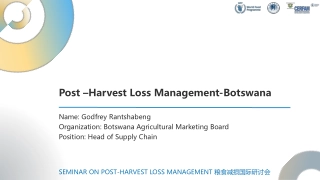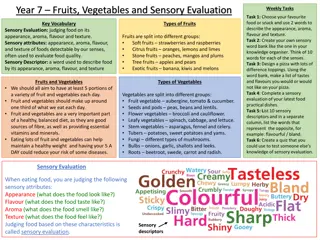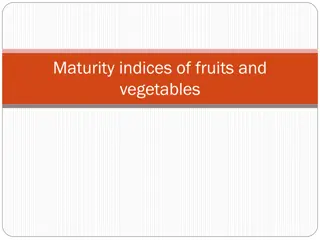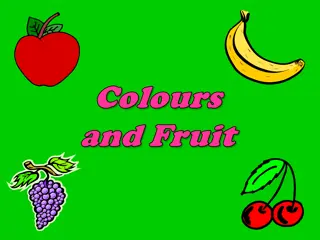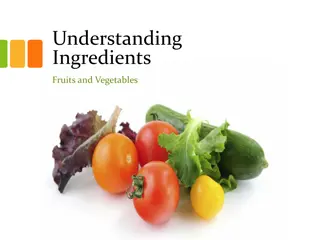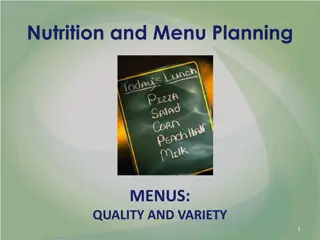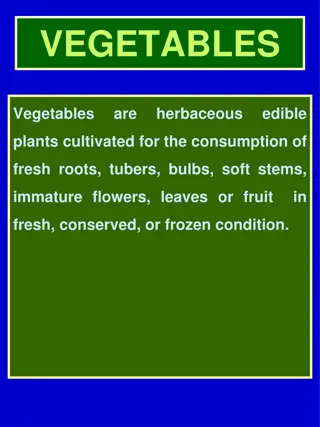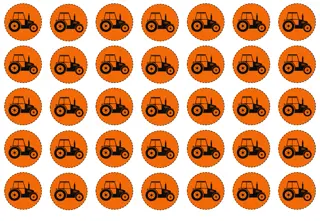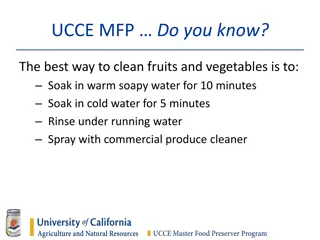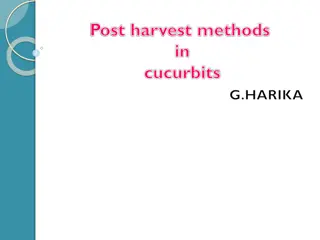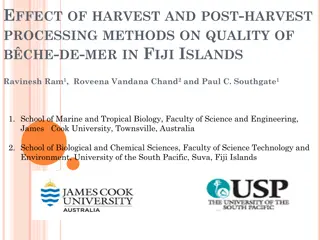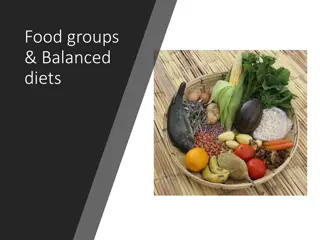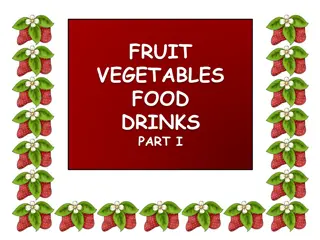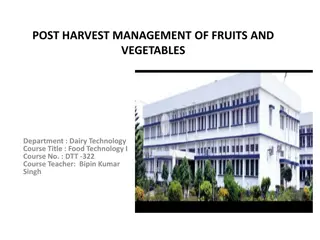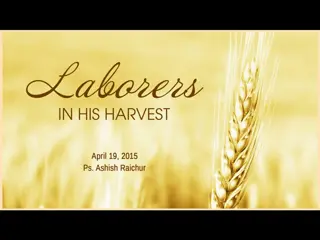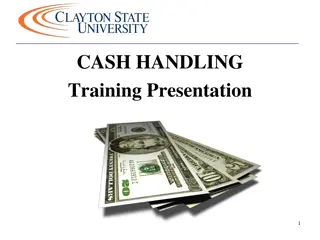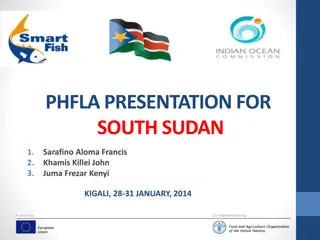Efficient Post-Harvest Handling Techniques and Technology for Fruits and Vegetables
Applying post-harvest technology to harvested fruits and vegetables focuses on maintaining quality and reducing losses. Effective management during this period is essential, with simple, low-cost technologies often being more appropriate than high-tech solutions for small-scale operations. Key handling steps include harvesting, pre-cooling, cleaning, trimming, grading, sorting, curing, sizing, waxing, packaging, transportation, wholesaler handling, retailer processing, and reaching the end consumer. Various methods of cooling are crucial in maintaining the quality of harvested commodities.
Download Presentation

Please find below an Image/Link to download the presentation.
The content on the website is provided AS IS for your information and personal use only. It may not be sold, licensed, or shared on other websites without obtaining consent from the author.If you encounter any issues during the download, it is possible that the publisher has removed the file from their server.
You are allowed to download the files provided on this website for personal or commercial use, subject to the condition that they are used lawfully. All files are the property of their respective owners.
The content on the website is provided AS IS for your information and personal use only. It may not be sold, licensed, or shared on other websites without obtaining consent from the author.
E N D
Presentation Transcript
POST HARVEST TRANSPORATATION AND STORAGE Mrs. Rajesh Kumari Deptt. Of Food Technology CBL Govt. Polytechnic, Bhiwani
POST HARVEST TECHNOLOGY The two main objectives of applying postharvest technology to harvested fruits and vegetables are to maintain quality (appearance, texture, flavour, nutritive value and safety) and to reduce losses between harvest and consumption. Effective management during the postharvest period, rather than the level of sophistication of any given technology, is the key in reaching the desired objectives. While large scale operations may benefit from investing in costly handling machinery and high-tech postharvest treatments, often these options are not available to small-scale handlers for the simple reason of economies of scale. Instead, simple, low cost technologies can be more appropriate for small volume, limited resource commercial operations, farmers involved in direct marketing, for home gardeners, as well as for handlers in developing countries.
POST HARVESTHANDLING Quality of harvested commodities cannot be further improved but it can be retained till their consumptionif the rate of metabolic activities are reduced by adopting the appropriate post harvest handling operations.
Post harvest handling operations 1. 2. 3. 4. 5. 6. 7. 8. 9. 10. 11. 12. 13. 14. 15. HARVESTING PRECOOLING CLEANING TRIMMING GRADING SORTING CURING SIZING WAXING PACKAGING TRANSPORTATION WHOLESALER TRANSPORTATION RETAILER CONSUMER 1. 2. 3. 4. 5. HARVESTING PRE-COOLING SORTING WASHING W AXING/CHEMICAL TREATMENT SIZING PACKAGING STORAGE TRANSPORTATION 10. WHOLESALER 11. RESTORING, RESIZING & REPACKAGING 12. TRANSPORTATION 13. RETAILER 14. CONSUMER FRUITS 6. 7. 8. 9. STORAGE VEGETABLES
1. PRE-COOLING- Removal of field heat from commodities, also reduces bruise damage from during transit. Cooling requirement varies with the air temperature during harvesting, stage of maturity and nature of crop. vibration COOLING METHOD COMMODITY Room cooling All fruits and vegetables Forced air cooling Fruits and fruit type vegetables, tubers and cauliflower Hydrocooling Stem, leafy vegetable, some fruits and fruit type vegetables Package icing Roots, stem, some flower type vegetables, green onions and brussel sprouts Vacuum cooling Some stem, some flower type vegetables Transit cooling Mechanical refrigeration Top icing & channel icing All fruits and vegetables Some roots, stems, leafy vegetables and cantaloupes Table-METHODS OF COOLING
2. WASHING, CLEANING AND TRIMMING Cleaning methods includes removal of soil dust, adhering debris, insects and spray residues, fungicides like Diphenylamine (0.1-.025%) or Ethoxyquin (0.2- 0.5%) may be used as superfical scald. For cleaning of some fruit type vegetables (melons, brinjals, tomatoes, cucumber) they should be wiped with damp cloth. Some vegetables need trimming, cutting and removal leaves or other vegetative parts. 3. SORTING, GRADING AND SIZING Sorting done by hand to remove fruits which are unsuitable to market and storage due damage by insects, diseases or mechanical injuries. Remainder crops is separated into two or more grades on basis of colour, shape or visible defects. For example, in apple packaging in India; its graded in 3 grades viz. Extra Fancy, Fancy and standard maybe packaged for marketing. The fourth being cull grade is meant for processing. After sorting and grading, sizing is done either by hand or machine. Machine sizer works on two principles- weight and diameter. Sizing based on fruit shape and size are most effective for spherical (Oranges, Tomato) and elongated (Europeanpears).
4.CURING Effective operation to reduce water loss during storage from hardy vegetables viz. Onion, Garlic, Sweet potato and other tropical root vegetables. Curing of root and tuber crops develops Periderms over cut, broken or skinned surfaces wound restoration. Helps in healing of harvest injuries, reduce loss of water and prevents infection by decay of pathogens. Curing of onion and garlic are done to dry necks and outer scales, the bulbs are left in the field after harvesting under shade for a few days until the green tops, outer skins and roots are fully dried. Commodity Temp c Rh Curing time Irish Potato 13-17 >85 7-15 Sweet Potato 27-33 >90 5-7 Yam 32-40 >90 1-4 Onionand Garlic 35-45 60-75 0.5-1 Cassava 30-35 >80 4-7 Table-Optimum condition for curing somevegetables
5.WAXING Quality retention is a major consideration in modern fresh fruit marketing system. Waxes are esters of higher fatty acid with monohydric alcohols and hydrocarbons and some free fatty acids. Waxing reduces transpiration and respiration rates, but other chemicals such as fungicides, growth regulators, preservatives can be incorporated specially for reducing microbial spoilage, sprout inhibitionetc. ADVANTAGES- Improved appearance Reduces moisture losses and retards wilting and shrivelling during storage of fruits Less spoilage due to chilling injury andbrowning Cost effective DISADVANTAGE- Development of off-flavour Attributed to inhibition of O2 and CO2 exchange, resulting in anaerobic respiration and elevated ethanol and acetaldehydecontent.
TYPES OFWAXES- 1. Solvent waxes- For citrus fruits consists of 70-80% aliphatic hydrocarbon and upto 25% aromatic hydrocarbons and solvents such as acetone, ethylacetate. 2. Water waxes- resin solution waxes and emulsion waxes, resin solution waxes are solution of one or more alkali-soluble resin or resin-like materials such as natural gums or wood resin. Emulsion waxes are composed of natural wax such as carnauba or paraffin or synthetic wax such as polyethyleneemulsion. 3. Paste or oil waxes- often used on vegetables, mainly composed of paraffins that are different in melting point and blended to a desiredviscosity. CATEGORIES OF WAX ACCORDING TO THEIRUSAGE- 1. STORAGE WAX-when fruit is not be marketedimmediately 2. PACK OUT WAX-when fruits are to be marketedimmediately 3. HIGH SHINE WAX-for giving a very high grace on marketdemand
LIST OF WAXES USED COMMERCIALLY 1. Paraffin wax 2. Carnauba wax 3. Bee wax 4. Micro crystallising waxes 5. Shellac 6. Wood resins 7. POLYETHYLENE (oxidized polyethylene wax or hydrocarbon wax) TRADE NAME OF SOME EXTENSIVELY USEDWAXES 1. Decco luter 2. Fruit and vegetable kleen 3. Frutox-emulsion of different waxes with 12% solids
6. PACKAGING Proper packaging reduces wastage of commodities by protecting them from mechanical damage, dirt, moisture loss and other undesirable physiological changes and pathological deterioration during the course of storage, transportation and subsequentmarketing. Packaging cannot improve the quality of the product but helps in maintaining it, as protects against the hazard of thejourney. To provide uniform quality to packed produce, commodity should be carefully supervised and sorted prior topackaging. Packaging boxes- wooden crates, woven baskets, jute sac, plastic punnets, corrugated fibre boardboxes.
PACKAGINGMATERIAL SPECIALITY CORRUGATED FIBRE BOARD (CFB) BOXES Light in weight, easy to handle , hygienic and recyclable. Made water proof by use of suitable adhesive or wax coating or a plastic film COMBINATION BOXES Made with plywood and CFB,gives high stack load capacity PLASTIC TRAYS OR CRATES Hygienic, light in weight, sturdy and recyclable and used in multi-trip packaging MOULDED PULP TRAYSOR THERMOFORMED PLASTIC TRAYS Cavities to hold individual apple fruit, prevents fruit from rubbing against each other often leads to surface cracks. STRETCH WRAPPING Retail marketing of fresh produce in form of cling plastic films MODIFIEDATMOSPHERIC PACKAGING Internal atmosphere can be optimized using mixture of gases like O2, N2, and CO2
The main aim of transportation is to move perishable products with minimum loss of quality. Most transportation equipment controls air temperature around the product. Horticultural produce maybe carried by road, rail, sea or air. High value perishables are transported by airr Ship- frozen meat, chilled carrots packaged in blocks and cartons Principles of ventilation, refrigeration, modified atmosphere applying to transportation similar to storage.
TRANSPORTATION BY RAIL- Takes 7-10 days, used for transport of potatoes, carrots, onions, citrus fruits. TRANSPORTATION BY AIR- Short transit times, expensive, provides poor temperature control compared to refrigerated land and sea transport methods. Used for transportation early season cherries, cut flowers, strawberries and some tropical fruits.
REFERENCES http://www.fao.org/wairdocs/x5403e/x5403e02.htm http://www.fao.org/wairdocs/x5403e/x5403e05.htm https://books.google.co.in/books?hl=en&lr=&id=O1zhx2OWftQC&oi=fnd&pg= PA1&dq=post+harvest+transportation&ots=4gyY2_ygJL&sig=bETu- LUUHg4W36Jd1dzV6St6L3w#v=onepage&q=transportation&f=false


